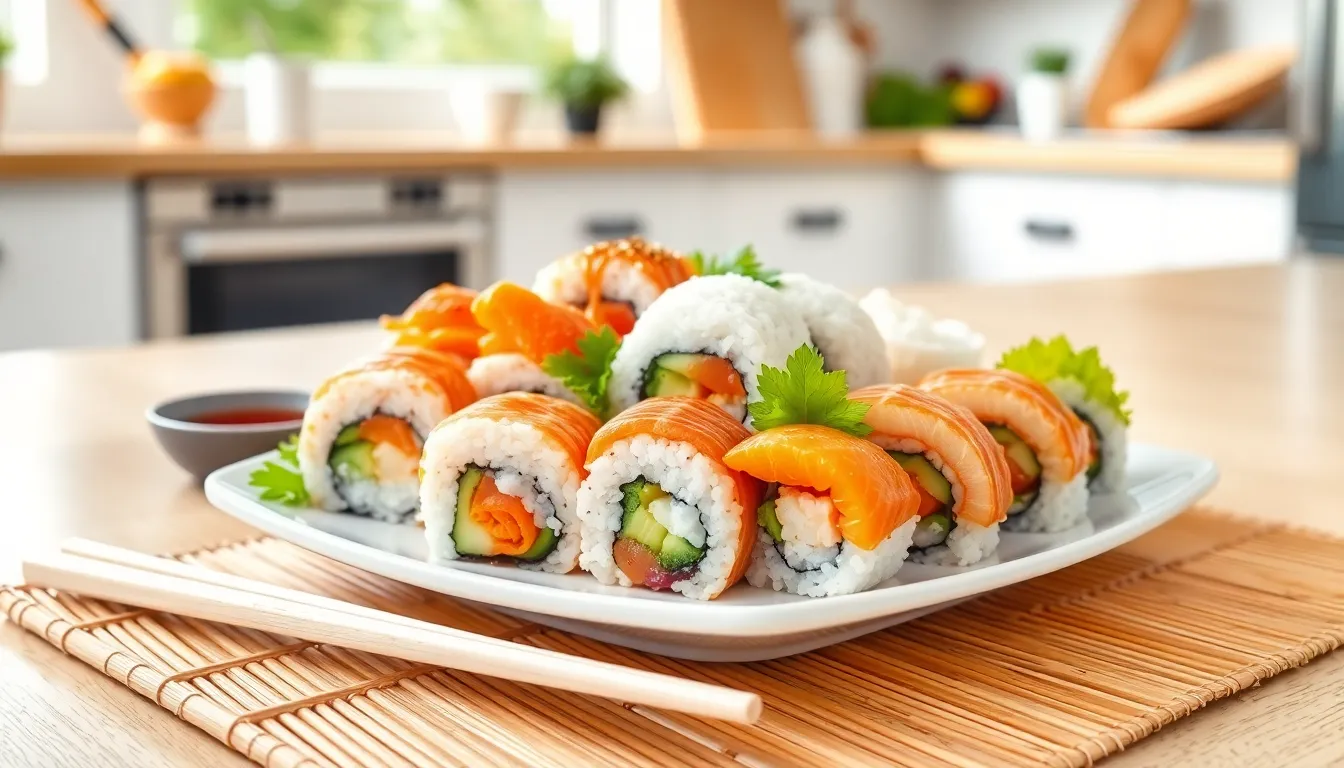Sushi might not be the first food that comes to mind when thinking about toddlers’ meals. After all, who wants to introduce their little ones to raw fish and seaweed? But before you dismiss the idea, consider this: sushi can be a fun and adventurous way to expand a toddler’s palate. Kids love to explore new flavors, and sushi offers a colorful array of ingredients that can spark their curiosity.
Table of Contents
ToggleCan Toddlers Eat Sushi?
Sushi can be a safe and enjoyable option for toddlers when prepared correctly. Ingredients like cooked fish, vegetables, and rice provide nutritious elements. Parents often worry about raw fish; however, many sushi varieties feature cooked options such as shrimp or eel.
Texture plays a crucial role in a toddler’s ability to eat. Sushi rolls with soft, easily chewable ingredients can be more palatable. In addition, using vegetables like avocado and cucumber can create a delightful experience.
Introducing sushi may also encourage toddlers to be more adventurous with their diets. Bright colors and unique shapes can make meals visually appealing, intriguing young children. Toddlers might enjoy simple rolls, such as California rolls, which include cooked imitation crab and cucumber.
Safety considerations remain vital. Always ensure fish is sourced from reputable suppliers. Check for freshness and avoid any potential allergens. Cut sushi into manageable pieces, preventing choking hazards.
Watching toddlers while they eat sushi can enhance their enjoyment. Encourage them to try different flavors and textures. This process can help develop their overall palate and foster a love for diverse meals.
Sushi can be an exciting culinary exploration for toddlers when prepared thoughtfully and with consideration for their safety.
Nutritional Benefits of Sushi for Toddlers

Sushi can offer toddlers numerous nutritional benefits when prepared with care. Parents can introduce a variety of healthy ingredients that support their child’s development and taste exploration.
Healthy Ingredients in Sushi
Sushi often contains wholesome ingredients like cooked fish, vegetables, and rice. Cooked fish, such as shrimp or crab, provides essential protein for growth. Fresh vegetables, including cucumber and avocado, supply vitamins and minerals that support overall health. Sushi rice contributes carbohydrates for energy. Seaweed, commonly used in sushi rolls, offers fiber and iodine, promoting healthy digestion and thyroid function. By selecting sushi made with these nutritious components, parents can create a balanced meal that excites toddlers’ taste buds.
Essential Nutrients for Growth
Sushi can deliver vital nutrients necessary for toddlers’ growth. Omega-3 fatty acids found in fish support brain development and cognitive function. Vitamins A and C from vegetables enhance immune health and skin vitality. Iron, present in some fish varieties, is crucial for red blood cell production. Calcium sourced from ingredients like seaweed supports bone strength. Providing sushi with a mix of these nutrients ensures that meals are beneficial and fosters a well-rounded diet, paving the way for lifelong healthy eating habits.
Safety Considerations
Sushi can be a safe option for toddlers when prepared thoughtfully. Specific precautions help reduce risks associated with sushi consumption.
Raw Fish Risks
Raw fish poses significant health risks, especially for young children. Bacteria and parasites present in uncooked seafood can cause foodborne illnesses. Opting for sushi made with cooked fish, such as shrimp or eel, lowers these risks. Parents should prioritize sushi varieties that avoid raw seafood altogether. When introducing sushi to toddlers, ensure all fish is sourced from reputable suppliers who guarantee freshness. This step protects not only against spoilage but also against harmful bacteria.
Allergies to Sushi Ingredients
Sushi ingredients may trigger allergic reactions in some toddlers. Common allergens include fish, shellfish, soy, and sesame. Careful ingredient checks are essential before serving sushi to young children. Offering sushi with non-allergenic ingredients reduces the likelihood of reactions. If a child has known allergies, parents should consult with a healthcare provider before introduction. Providing a safe eating experience by selecting ingredients wisely fosters exploration without unnecessary risk.
Age-Appropriate Sushi Options
Toddler-friendly sushi involves selecting appropriate ingredients and preparations. Parents can introduce their children to sushi by offering several safe and exciting options.
Cooked Sushi Variations
Cooked sushi variations present ideal choices for toddlers. Shrimp tempura rolls combine crispy shrimp and vibrant vegetables, offering appealing textures. Eel nigiri features cooked eel, which provides a sweet, rich flavor that many toddlers enjoy. California rolls include imitation crab, cucumber, and avocado, making them visually enticing. Each option avoids raw fish, minimizing health risks while encouraging exploration of different flavors.
Vegetarian Sushi Choices
Vegetarian sushi choices cater to young diners with diverse taste preferences. Cucumber rolls offer a refreshing crunch that many toddlers find enjoyable. Avocado rolls provide creamy, rich textures, enhancing the overall sushi experience. Vegetable tempura rolls feature a variety of crispy, cooked veggies, introducing new tastes while keeping meals safe. Providing these options helps expand toddlers’ palates while ensuring safe, nutritious eating experiences.
Introducing Sushi to Your Toddler
Sushi offers a vibrant culinary experience that can engage toddlers’ taste buds and curiosity. With careful preparation, parents can introduce their little ones to this exciting meal option.
Tips for First-Time Sushi Eaters
Start with simple, cooked options like California rolls or shrimp tempura rolls to ease toddlers into the world of sushi. Select sushi made with ingredients that are easy to chew, avoiding anything too tough or chewy. Consider cutting sushi into small, bite-sized pieces to help prevent choking hazards. Always supervise during mealtime to ensure safety with new foods. Introducing one ingredient at a time allows parents to monitor for potential allergies. Always consult with a healthcare provider for personalized advice if toddlers have existing allergies.
Making Sushi Fun and Engaging
Turn the sushi experience into a fun, hands-on activity by involving toddlers in the preparation process. Create a sushi-making station with colorful ingredients, letting them choose their favorites. Offer a variety of shapes and colors to spark excitement. Consider using cookie cutters to make sushi visually appealing. Incorporate playful names for each roll to enhance their interest. Offering dipping sauces like soy sauce or avocado mayo makes the experience interactive. Celebrating each successful sushi creation encourages toddlers to explore new flavors without hesitation.
Introducing sushi to toddlers can be a delightful way to expand their culinary horizons. By opting for cooked varieties and nutritious ingredients, parents can ensure a safe and enjoyable experience. The vibrant colors and diverse textures of sushi can engage toddlers’ curiosity and encourage them to embrace new flavors.
With careful preparation and attention to potential allergens, sushi can become a fun and healthy meal option. Making sushi a hands-on activity can further enhance a child’s interest in food. As they explore different ingredients and flavors, toddlers can develop a lifelong appreciation for diverse and nutritious meals.




